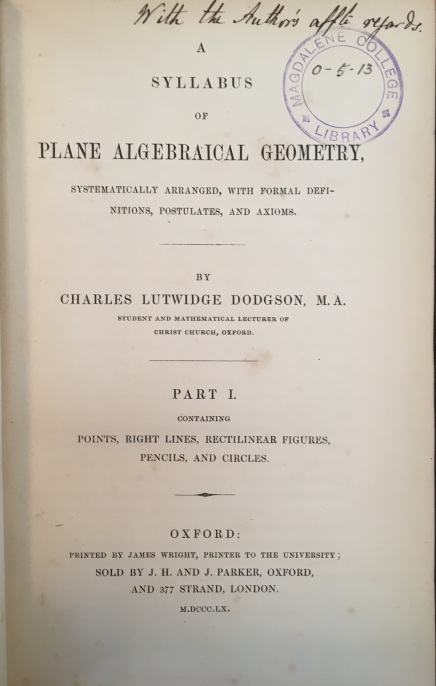The library staff at Magdalene have now completed the online cataloguing of the 19th and 20th century mathematical and scientific books in the Old Library. The collection is chiefly made up of books given by A.S. Ramsey, who was a lecturer in Mathematics at Magdalene from 1897-1934. Among the most notable scientists featured in his collection are André-Marie Ampère, James Clerk Maxwell and Pierre-Simon Laplace. One book in the collection which is also highly likely to have been donated by A.S. Ramsey is by Charles Dodgson, better known by his pen name Lewis Carroll. A.S. Ramsey’s wife, Mary Agnes Wilson, was acquainted with Carroll, a lecturer at Oxford, during her time as an undergraduate there, and she attended his logic classes at her college. Carroll later gave her a presentation copy of Alice’s adventures in Wonderland. Unfortunately this book isn’t in the Old Library Collection, but it is probable that our copy of A syllabus of plane algebraical geometry came to the library via the route of Mary Agnes Wilson and A.S. Ramsey. It features Carroll’s handwriting on the top of the title page, ‘With the Author’s affte [affectionate] regards’.

Old Library O.5.13: Dodgson, Charles: A Syllabus of plane algebraical geometry…Oxford: Printed by James Wright, 1860.
Lewis Carroll was born Charles Lutwidge Dodgson in 1832. He was the son of a clergyman, Charles Dodgson, who eventually became the canon of Ripon Cathedral, and the third of eleven children. Carroll’s fascination with mathematics was apparent at an early age. He was home-schooled until he was twelve, and was exceptionally keen for his father to explain the meaning of logarithms to him during his home schooling. After attending Richmond School and Rugby, he arrived at Christ Church, Oxford in 1851. When Carroll completed his undergraduate degree he was nominated for a life fellowship of the college and became a lecturer in 1855.
A syllabus of plane algebraical geometry, systematically arranged, with formal definitions, postulates, and axioms was Carroll’s first mathematics book. Published in 1860 the book has been described by Cohen as an ‘effort to translate some of Euclid into algebraical terms and to claim for analytical geometry a greater role in developing reason and logical thinking than was generally conceded’. Geometry, logic and analysis of Euclid became Carroll’s main areas of research during his time at Oxford.
Although Carroll’s mathematical work has been revisited in the 20th century, it was not considered exceptional in its day. There has been, however, much discussion about the influence of mathematics and logic in Carroll’s literary works such as Alice’s Adventures in Wonderland. Bayley argues that Carroll’s dissatisfaction with contemporary mathematical research, which had departed from the benchmark of Euclid’s meticulous reasoning and logic, led to Carroll exploring these ideas in his fiction books:
‘Dodgson took his mathematics to his fiction. Using a technique familiar from Euclid’s proofs, reductio ad absurdum, he picked apart the “semi-logic” of the new abstract mathematics, mocking its weakness by taking these premises to their logical conclusions, with mad results. The outcome is Alice’s Adventures in Wonderland.’
By Catherine Sutherland
Deputy Librarian, Pepys Library and Special Collections
Bibliography:
Abeles, Francine F. ‘Mathematics: Logic and Lewis Carroll’. Nature 527, no. 7578 (19 November 2015): 302–4. doi:10.1038/527302a.
Bayley, Melanie. ‘Alice’s Adventures in Algebra: Wonderland Solved’. New Scientist. Accessed 7 December 2016. https://www.newscientist.com/article/mg20427391-600-alices-adventures-in-algebra-wonderland-solved/.
‘Bonhams : DODGSON (CHARLES LUTWIDGE) “Lewis Carroll”’. Accessed 7 December 2016. http://www.bonhams.com/auctions/16204/lot/379/?category=list.
Cohen, Morten N. ‘Dodgson, Charles Lutwidge [Lewis Carroll] (1832–1898)’, Oxford Dictionary of National Biography, Oxford University Press, 2004; online edn, Sept 2013 [http://www.oxforddnb.com/view/article/7749, accessed 7 Dec 2016]